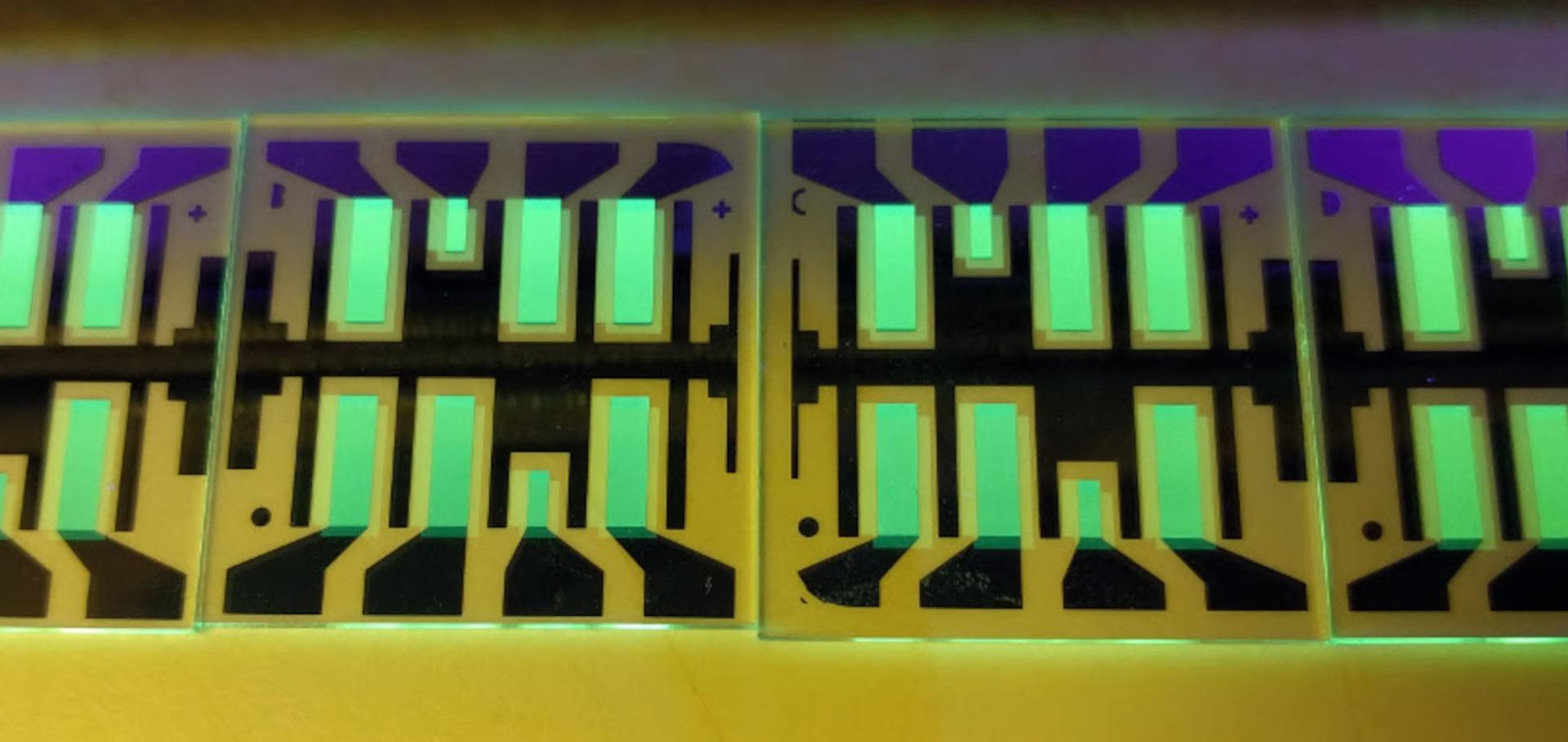Self-passivation of molecular n-type doping during air exposure using a highly efficient air-instable dopant
Physica Status Solidi (A) Applications and Materials Science 210:10 (2013) 2188-2198
Abstract:
In contrast to p-dopants, highly efficient molecular n-dopants are prone to degradation in air due to their low ionization potentials, limiting the processing conditions of doped functional organic devices. In this contribution, we investigate the air-stability of pure films of the n-dopant tetrakis(1,3,4,6,7,8-hexahydro-2H-pyrimido[1,2-a]pyrimidinato)ditungsten(II) (W2(hpp)4) and of C60 layers doped by W2(hpp)4. We find that 1/3 of the initial conductivity of the doped C60 thin films can be restored by thermal annealing in vacuum after a drop by 5 orders of magnitude upon air exposure. Furthermore, we show by ultraviolet photoelectron spectroscopy (UPS) and Seebeck measurements that the Fermi level shift toward the lowest unoccupied molecular orbital (LUMO) of C60 remains after air exposure, clearly indicating a conservation of n-doping. We explain these findings by a down-shift of the W2(hpp)4 energy levels upon charge-transfer to a host material with deeper lying energy-levels, facilitating a protection against oxidation in air. Consequently, the observed recovery of the conductivity can be understood in terms of a self-passivation of the molecular n-doping. Hence, an application of highly efficient n-doped thin films in functional organic devices handled even under ambient conditions during fabrication is feasible. © 2013 WILEY-VCH Verlag GmbH & Co. KGaA, Weinheim.Electric potential mapping by thickness variation: A new method for model-free mobility determination in organic semiconductor thin films
Organic Electronics: physics, materials, applications 14 (2013) 3460-3471
Abstract:
Charge transport, with charge carrier mobility as main parameter, is one of the fundamental properties of semiconductors. In disordered systems like most organic semiconductors, the effective mobility is a function of the electric field, the charge carrier density, and temperature. Transport is often investigated in a space-charge limited current (SCLC) regime in thin film single carrier devices, where an electric current is driven in the direction perpendicular to the surface. Direct evaluation of the current-voltage characteristics, however, is problematic, because parasitic contributions from injection or extraction barriers can falsify results. Here, we present a novel measurement and evaluation technique for key transport parameters. First, it allows for the direct determination of the potential profile in single carrier devices. It is obtained from a series of steady-state current-voltage measurements from devices with varying thickness ("electric potential mapping by thickness variation", POEM). Second, the data can be evaluated to obtain the effective charge carrier mobility μ(F, n) as a function of the electric field F and the charge carrier density n. Single carrier transport is achieved by sandwiching the organic material under investigation between equally doped layers, i.e. p-i-p (resp. n-i-n) devices for hole (electron) transport investigations. The POEM concept is validated using drift-diffusion simulation data. It is furthermore experimentally applied to small molecular organic semiconductors, where the hole transport in a blend of zinc phthalocyanine (ZnPc) and C is characterized. In the measured range of F ≈ (1-5) × 10 V/cm and hole densities of approx. (1-5) × 10 cm, the hole mobility is found to be in the range of (10-10) cm/V s, comprising a pronounced field activation with an activation constant of 0.01 sqrt(cm / V). A dependence of the mobility on the charge carrier density in the given range is not observed. The POEM approach does not require a given mobility function as input, i.e. it constitutes a model-free determination of the effective mobility μ(F, n). It is especially suitable for semiconductors which require complex mobility models, like hopping or trap-dominated transport in disordered systems, and relatively low mobilities, like e.g. neat or mixed organic semiconductors. © 2013 The Authors.Correlation of open-circuit voltage and energy levels in zinc-phthalocyanine: C60 bulk heterojunction solar cells with varied mixing ratio
Physical Review B - Condensed Matter and Materials Physics 88:8 (2013)
Abstract:
The maximum open-circuit voltage V of bulk-heterojunction solar cells is limited by the effective HOMO(donor)-LUMO(acceptor) gap of the photoactive absorber blend. We investigate blend layers comprising zinc-phthalocyanine (ZnPc) and the buckminster fullerene C with ultraviolet, x-ray, and inverse photoelectron spectroscopy. By varying the volume mixing ratio ZnPc:C from 6:1 to 1:6, we observe a linear increase of the HOMO(ZnPc)-LUMO(C) gap by 0.25 eV. The trend in this gap correlates with the change in the charge transfer energy measured by Fourier-transform photocurrent spectroscopy as well as with the observed open-circuit voltage of solar cells containing ZnPc:C as the photoactive absorber layer. Furthermore, the morphology of different ZnPc:C blend layers is investigated by grazing-incidence x-ray diffraction. As physical origins for the changed energy levels, a suppressed crystallization of the C phase in the presence of donor molecules as well as concentration-dependent growth modes of the ZnPc phase are suggested. © 2013 American Physical Society.Molecular ordering and charge transport in a dicyanovinyl-substituted quaterthiophene thin film
RSC Advances 3:30 (2013) 12117-12123
Abstract:
By combining computer simulations, grazing incidence, and powder X-ray-diffraction measurements we reconstruct the crystal structure of a thin film of terminally dicyanovinyl-substituted quaterthiophene (DCV4T). The crystal structure differs from the known single crystal structure of the same compound, but resembles the molecular packing of a methylated DCV4T. Charge transport simulations on the molecular level show that the 2 dimensional thin-film charge-transport network is well suited for hole transport in solar cells. © The Royal Society of Chemistry 2013.Investigation of driving forces for charge extraction in organic solar cells: Transient photocurrent measurements on solar cells showing s-shaped current-voltage characteristics
Advanced Energy Materials 3:7 (2013) 873-880


